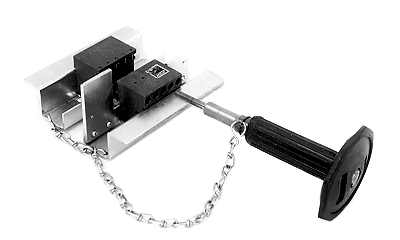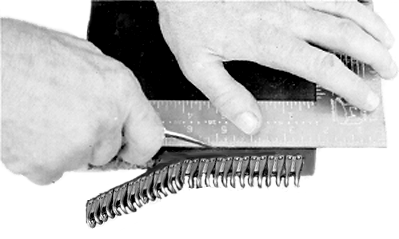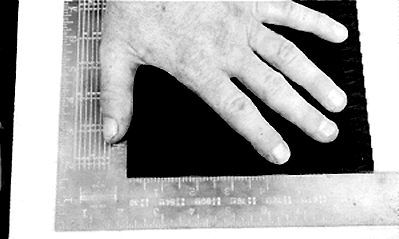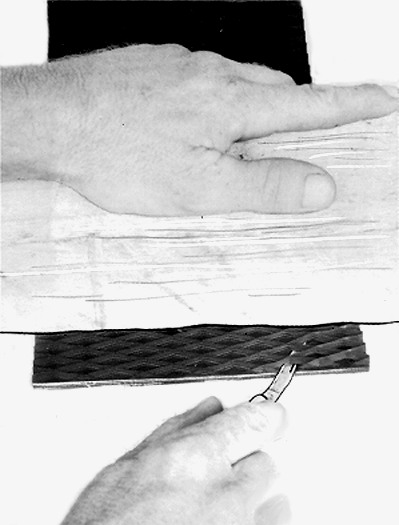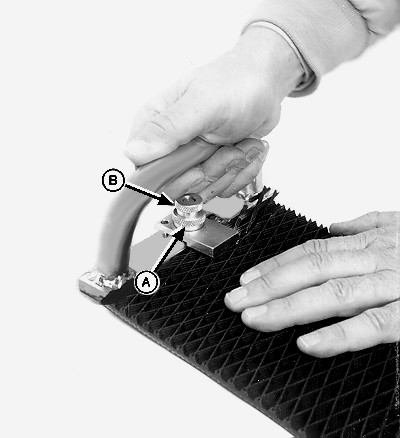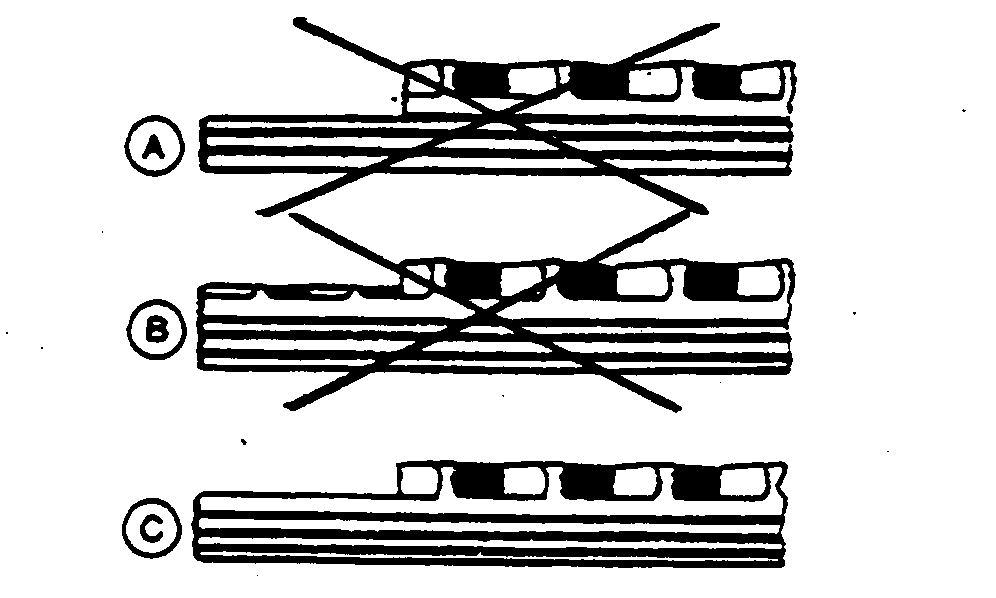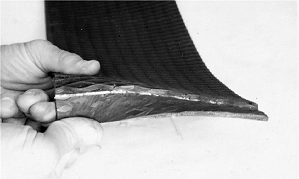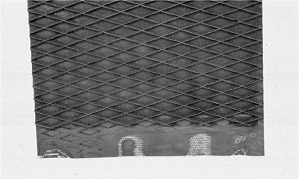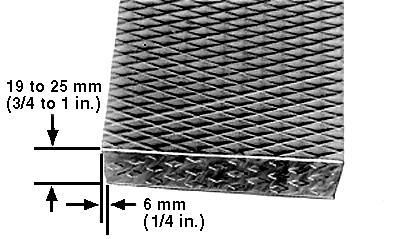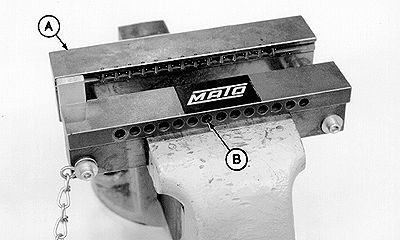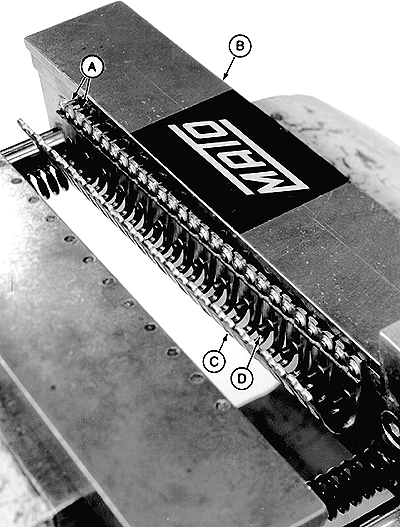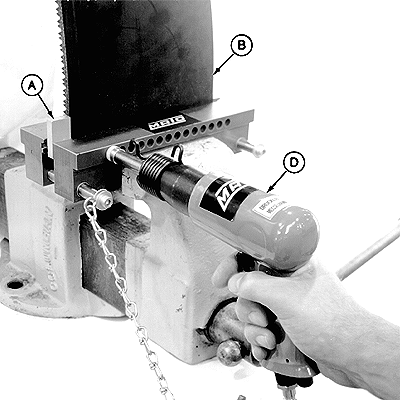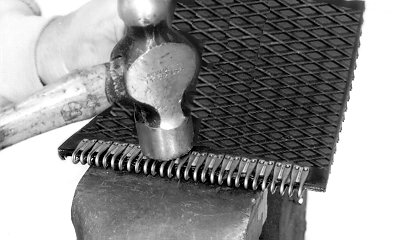Repairing BeltsA belt lacing tool is available for repairing belts. NOTE: Belts may fray at the edges. Cutoff the frayed cords as they appear; this reduces the chances of frayed cords being caught as the bale is formed, causing additional fraying or damage to the belts. 1. Remove broken belt. |
|
OUMX005,0000080 -19-02OCT00-1/11 |
|
2.
Remove damaged area using a square and a sharp knife. Check to be sure belt end was cut squarely.
IMPORTANT: If belt lengths are less than specified, belts will contact each other between the rear two tension arm rollers when baler is empty and gate is closed. When this happens, excessive wear to the belt diamond pattern will occur. Make sure all belts are within 38 mm (1-1/2 in.) of the other belts of similar length. There should not be more than 152 mm (6 in.) difference between the long and short belts. NOTE: If belts are shorter than the specified dimensions, a short piece of belt may be added. Splices (on same belt) should be at least 305 mm (12 in.) apart. 3. Check belt length. Make sure belt is neither longer or shorter than specified. |
|
| Belt Lengths | |||
|---|---|---|---|
| mm (in.) | Minimum | Repair | Maximum |
| Short Belts | 11633 (458) | 11709 (461) | 11760 (463) |
| Long Belts | 11773 (463-1/2) | 11849 (466-1/2) | 11900 (468-1/2) |
OUMX005,0000080 -19-02OCT00-2/11 |
|
IMPORTANT: Cut only the diamond pattern. Cutting deeper can damage the belt cords. Do not use a grinder to remove diamond pattern. Heat from grinder can cause damage to rubber and fabric. 4. Remove diamond pattern from belt using a knife or skiving tool.
NOTE: To reduce cutting effort, dip knife blade in liquid soap. |
|
OUMX005,0000080 -19-02OCT00-3/11 |
|
|
OUMX005,0000080 -19-02OCT00-4/11 |
|
IMPORTANT: Do not leave more than 0.5 mm (0.020 in.) of pattern on belt in area to be laced. If too much material is left on belt, hooks will not fasten properly to belt. Do not remove too much material. If belt cords show, repeat Steps 2-4. Make sure belt length is still within specifications. Add section of belt if necessary. Belt (A) is cut too deep. Damage to belt cords will occur. Belt (B) is cut too high. Hooks will not fully penetrate through the belt. Belt (C) is cut correctly. |
|
OUMX005,0000080 -19-02OCT00-5/11 |
More examples of incorrectly cut belts: |
|
OUMX005,0000080 -19-02OCT00-6/11 |
|
IMPORTANT: Trailing end of belt must be trimmed using dimensions shown in illustration. DO NOT vary from these dimensions. 5.Trim trailing end of belt as shown. |
|
OUMX005,0000080 -19-02OCT00-7/11 |
|
Put belt lacer tool (A) in vice with holes (B) toward the operator. The shoulder of lacer should rest on jaws of vise.
|
|
OUMX005,0000080 -19-02OCT00-8/11 |
|
Install lacing strip (C) in lacer tool (B). Make sure two rivet pins (A) of each lacing segment is inserted into each of the tools' 14 holes. The lacing segments should rest against stop pins (D). Tighten vise until lacing strip is lightly gripped and belt can be easily inserted.
|
|
OUMX005,0000080 -19-02OCT00-9/11 |
Install belt (B) in lacing strip with diamond pattern away from operator. While holding edge of belt against stop plate (A), uniformly push belt down to the stop pins. Make sure lacing strip is against stop pins. Make sure belt and lacing are positioned squarely in lacer tool. Close vise on belt and lacing until distance between lacer jaws equals width of belt. IMPORTANT: If using a hand punch, using too large of a hammer or striking punch too hard can damage lacing tool or belt lacing. If using pneumatic hammer, too high air pressure and/or too long riveting time can damage lacing tool or belt lacing. 11.Drive rivets through belt using a punch (C) or pneumatic hammer (D). Rivet the two outer lacing segments first, then working from the outside to the inside, rivet the rest of lacing segments. Remove belt from vise and inspect lacing. All rivets should be driven through belt and show punch marks in center of rivets.
|
|
OUMX005,0000080 -19-02OCT00-10/11 |
|
IMPORTANT: Do not hit loop area of fastener when using hammer to flatten heads of rivets. Do not hit rivets too hard or rivets may buckle and damage joints. 13.Put belt and lacing on a solid base. Flatten heads of rivets using the flat face of a small hammer. Strike several rivets at a time using a light tapping motion. Rivets should be flush with splice. Repeat procedure for other end of belt. |
|
OUMX005,0000080 -19-02OCT00-11/11 |
